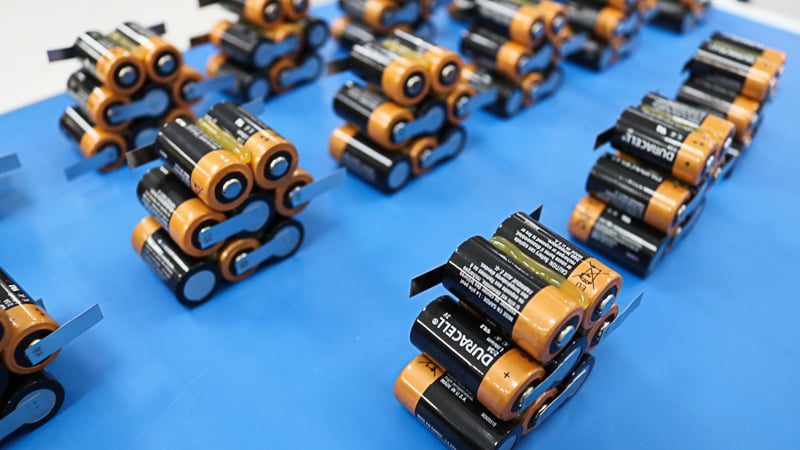Whether it is a medical device concept, automotive manufacturing, project, industrial application, or consumer product, companies require large and small battery packs that will ensure their electronic devices and machinery have the longest life cycles without any safety issues. Many of hese battery packs need to be custom made for the specific device before they can be marketed.
Yet, managing your time when undergoing the product development, testing, marketing, and selling of your device can be slowed down when requiring a battery pack made from scratch. It can be a tricky business, as you don't want to build the entire product line before the battery pack development phase is completed. You may find out that the mechanical design of your battery pack will not fit into the device or that the electrical specifications of the battery pack isn't suitable to the power needs of the device.
Here at Epec, we are helping all electronic market segments with their custom battery pack needs with our design and manufacturing capabilities. We can also help you improve your battery pack's time-to-market efforts. There are several validation processes and specification requirements that you should be aware of to eliminate issues early in the design, development, and packaging phases for your battery pack.
In this blog post we will review 5 ways to make time to market improvements when obtaining custom batteries.

Custom battery packs during the assembly process.
Proof of Concept Validation for Battery Pack Power
During your proof of concept for the application, you've determined the electronic device's feasibility, capabilities, and desired functions over a long range of time. Yet, you also need to validate the device's power needs. Certain applications may go through different types of environmental stresses and loads. This can change the way your device functions, as it may require more power to operate than when it is used in a more controlled and stable environment.
For example, there may be times when your device will be used in cold environments, as battery packs will discharge quicker in lower temperatures. So, not only will you have to ensure that the device design will further protect the battery pack in this environment, you also need to figure out the changing power needs of the device to ensure it continues to work as required.
Many companies find that determining the battery life for the device can be a significant hurdle to the process as well as time-consuming. When validating your proof of concept, you should request sample batteries or prototypes that have varying chemistries, housing components, and other requirements (waterproofing and flammability specifications) to use during device testing. By obtaining the sample batteries and prototypes online, you'll be able to create benchtop battery pack prototype data. This necessary data can further hone your battery pack specification requirements when it comes to selecting the appropriate battery chemistry.
Battery Pack Electrical and Mechanical Design
The battery pack's electrical and mechanical designs will need to be created and tested. With the proof of concept validated from the benchtop prototypes, you should be able to narrow down the battery specifications that will work best with the device.
Battery pack requirements may include deciding on:
- Plastic or metal housing enclosures
- Wire harnesses
- Specialty connectors such as an IP67-compliant locking mechanism or gold-plated PCN
- Heating solutions
- Protection circuitry and BMS
Then, your engineers should be able to take these designs and change or improve them to ensure that there will be no negative effects created between the materials used for the battery pack and the device, as well as checking that the electrical components will properly connect and provide adequate power to the device. Then, the designs can be passed on to the battery supplier.
3D Printing Mechanical Design Proofing
Tooling the battery pack's enclosure can be a very involved and lengthy process. This procedure can often push out lead times, which can be further delayed if there is even a single dimension or specification that is incorrect regarding the mechanical design. While Epec can improve time-to-market processes by using Fused Deposition Modeling (FDM) to create conceptual models, engineering models, and prototypes of the customized battery pack's enclosure, you can also further shorten the time to market process by using 3D printing.
Since the mechanical and electrical designs have been developed and proven in the last step, you can 3D print the battery pack prototype to verify the mechanical design when placed into the device. This step ensures the battery pack will be formed to fit the device as specified from your mechanical design requirements. We can also use the data collected from the 3D printing process to assist with our tooling procedures when crafting the enclosure.
From this 3D printing proofing phase, you will be able to develop 3D drawings that can benefit the battery supplier (2D drawings of the enclosure's exterior is the minimum that would be required). These drawings can help to give additional details regarding the finish, color, and materials to be used.
Custom Packaging Development and Shipping Requirements
With the mechanical design locked in, you should now move on to the custom packaging design phase. The packaging can vary based on the complexity of the design and the type of battery chemistry that has been selected, such as lithium-based batteries. The battery pack may be supplied in a soft pack or within an enclosure, as you will want to test to ensure that the packaging is up to shipping standards based on where your device will be used.
You will also need to understand all shipping requirements. If transporting lithium-based batteries, your company and shipping department will need to be certified to be in compliance with DOT regulations. Becoming familiar with US38.3 transportation requirements will ensure that the packaging design will pass all rigorous shipping and transportation testing to gain approval.
Market Segment Determination
While your engineers will be developing the electrical and mechanical designs for the battery pack that will be handed over to the battery supplier, you and your team will need to decide on the market segment that will be using your devices. While this seems obvious from the proof of concept stage of your device, the battery pack design and build can impact your ability to offer these devices to certain industries unless you receive the appropriate certifications.
Specific industries that will require testing and documentation include medical, aerospace, and the military. Some of these requirements include serialization of the battery pack as well as the components in the device for medical applications. In military and aerospace, companies will need the battery packs to pass all Highly Accelerated Life Testing (HALT) and Highly Accelerated Stress Screen Testing (HAST) requirements before being placed into use to check for any rapid fatigue or defects. Other companies may have certification requirements to check for shock and vibration limits, extreme temperatures, and other factors.
To pass these certifications, your device and custom battery pack will need to be thoroughly tested. Your team will be able to evaluate which markets will require certifications, the types of tests that will be performed, and how many sample quantities will be needed that will undergo the testing. In addition, companies that require certification testing will usually have a timeline on how long testing will take place.
With all this information, you can better time when testing and certification will be completed so that your custom battery packs can then be manufactured and shipped to your site to meet your production deadlines. You'll also be able to develop a time frame if testing reveals any design flaws with the device that will need to be addressed.
Reducing the Developmental Timeline
From the validation phase to the marketing research, performing these initial steps can allow battery suppliers to speed up the battery pack development process. Then, we can move on to the scope of the project and the production phases. By supplying as much information as possible, a battery supplier will begin their design and manufacturing procedures. Here at Epec, this process is as follows:
- Application Review: We gain all documentation regarding the battery pack and speak with your engineering team regarding specifications.
- Scope Development: All documentation is collected and gathered as we create a first draft of the battery pack proposal to outline all your requirements.
- Scope Refinement: We have a specification meeting with the customer to go over any project changes based on materials, budgets, or requirements.
- Development Process: After scope confirmation, we begin the development by creating the control circuitry, BOM, and Gerber data while procuring materials, producing prototypes, and performing PCBA testing.
- Prototype Completion & Testing: We complete the prototypes for bench testing and then submit them to the customer for device testing.
- Non-Lithium Battery Production: For battery pack prototypes that are not lithium-based, we get the materials to create the battery packs and create the production test fixture.
- Lithium-Based Battery Regulatory Approval: After battery prototype approval from the customer, lithium-based batteries must be certified with DOT US38.3 transportation standards. Testing will be destructive as the prototypes will not be reclaimed.
- UL Certification: After US38.3 transportation testing, sometimes UL certification will be required as we submit the prototypes and documentation to the testing agency.
-
Lithium Battery Production: When the lithium-based battery prototypes pass this certification phase, then the production process will proceed.
Summary
Always be aware that lead times will vary significantly from the moment a battery chemistry is selected, especially when selecting lithium-based batteries due to regulatory requirements. Having thorough documentation for the battery supplier from the offset and being available for the battery pack application reviews and the scope refinement phases will help to improve the time to market for your battery packs. Also, the moment that you have a device concept that will require a battery pack, contact an approved battery pack assembler, such as Epec. We can help you determine the type of documentation and data that will be needed to make our development process move quickly.
Key Takeaways
- Validate power needs early: Proof of concept testing should include battery prototypes with different chemistries and housings to ensure the pack can handle environmental stresses, such as cold temperatures that affect discharge rates.
- Develop robust electrical and mechanical designs: Defining enclosures, connectors, wire harnesses, and protection circuitry upfront helps avoid integration problems and ensures the pack delivers consistent performance in the device.
- Leverage 3D printing for design proofing: Rapid prototyping of enclosures allows engineers to confirm fit and function before committing to tooling, reducing rework and shortening lead times.
- Plan for packaging and shipping compliance: Packaging must meet safety and regulatory requirements, especially for lithium-based packs, which require DOT and UN 38.3 certification for transport.
- Align designs with target markets and certifications: Medical, aerospace, and military applications demand specific testing and documentation, so identifying certification needs early on keeps projects on schedule and avoids costly delays.
















